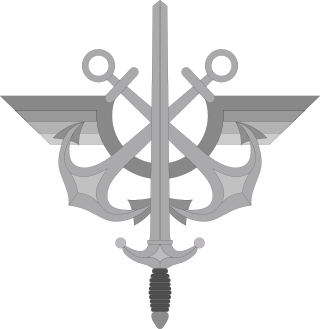
The French Armed Forces are the military forces of France. They consist of four military branches – the Army, the Navy, the Air and Space Force and the National Gendarmerie. The National Guard serves as the French Armed Forces' military reserve force. As stipulated by France's constitution, the president of France serves as commander-in-chief of the French military. France has the eighth largest defence budget in the world and the second largest in the European Union (EU). It also has the largest military by size in the EU. A 2015 Credit Suisse report ranked the French Armed Forces as the world's sixth most powerful military.

The Italian Armed Forces encompass the Italian Army, the Italian Navy and the Italian Air Force. A fourth branch of the armed forces, known as the Carabinieri, take on the role as the nation's military police and are also involved in missions and operations abroad as a combat force. Despite not being a branch of the armed forces, the Guardia di Finanza is organized along military lines. These five forces comprise a total of 340,885 men and women with the official status of active military personnel, of which 167,057 are in the Army, Navy and Air Force. The President of the Italian Republic heads the armed forces as the President of the High Council of Defence established by article 87 of the Constitution of Italy. According to article 78, the Parliament has the authority to declare a state of war and vest the powers to lead the war in the Government.
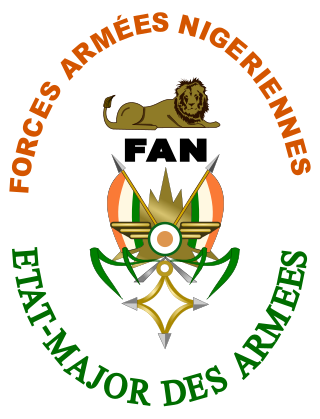
The Niger Armed Forces includes military armed force service branches, paramilitary services branches and the National Police of Niger. The Army, Air Force and the National Gendarmerie are under the Ministry of Defense whereas the National Guard and the National Police fall under the command of the Ministry of Interior. With the exception of the National Police, all military and paramilitary forces are trained in military fashion. The President of Niger is the supreme commander of the entire armed forces. The National Assembly of Niger passed a statute for the Army of Niger in November 2020, planning for the army's size to increase from 25,000 personnel in 2020, to 50,000 in 2025 and finally 100,000 in 2030.

The Gambia Armed Forces, also known as the Armed Forces of The Gambia, consists of three branches: the Gambia National Army (GNA), the Gambia Navy, and the Republican National Guard (RNG). It formerly included the Gambia National Gendarmerie (GNG) from the 1980s to 1996, when they were moved under the jurisdiction of the Ministry of the Interior. The commander-in-chief is the president of the Gambia who is currently Adama Barrow, whereas practical control is exercised by the Chief of the Defence Staff who is currently Lieutenant General Yankuba Drammeh.

A paramilitary is a military that is not part of a country's official or legitimate armed forces. The Oxford English Dictionary traces the use of the term '"paramilitary" as far back as 1934.

Military police (MP) are law enforcement agencies connected with, or part of, the military of a state. In wartime operations, the military police may support the main fighting force with force protection, convoy security, screening, rear reconnaissance, logistic traffic management, counterinsurgency, and detainee handling.

A gendarmerie is a military force with law enforcement duties among the civilian population. The term gendarme is derived from the medieval French expression gens d'armes, which translates to "men-at-arms". In France and some Francophone nations, the gendarmerie is a branch of the armed forces that is responsible for internal security in parts of the territory, with additional duties as military police for the armed forces. It was introduced to several other Western European countries during the Napoleonic conquests. In the mid-twentieth century, a number of former French mandates and colonial possessions adopted a gendarmerie after independence. A similar concept exists in Eastern Europe in the form of Internal Troops, which are present in many countries of the former Soviet Union and its former allied countries.

National guard is the name used by a wide variety of current and historical uniformed organizations in different countries. The original National Guard was formed during the French Revolution around a cadre of defectors from the French Guards.
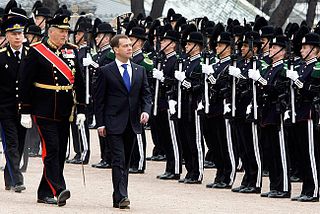
In some militaries, foot guards are senior infantry regiments. Foot guards are commonly responsible for guarding royal families or other state leaders, and they also often perform ceremonial duties accordingly, but at the same time are combat soldiers.
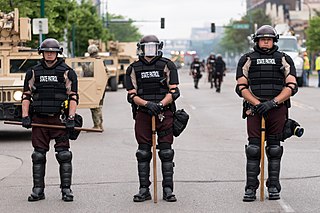
Riot police are police who are organized, deployed, trained or equipped to confront crowds, protests or riots.

Law enforcement in France is centralized at the national level. Recently, legislation has allowed local governments to hire their own police officers which are called the police municipale.
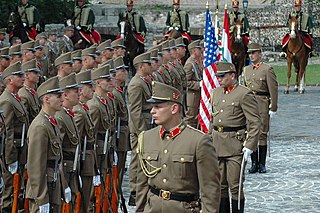
A guard of honour, honor guard or ceremonial guard, is a group of people, typically drawn from the military, appointed to perform ceremonial duties – for example, to receive or guard a head of state or other dignitaries, the fallen in war, or to attend at state ceremonials, especially funerals. In military weddings, especially those of commissioned officers, a guard, composed usually of service members of the same branch, form the sabre arch. In principle, any military unit could act as a guard of honour. However, in some countries, certain units are specially assigned to undertake guard of honour postings or other public duties. Republican guards, royal guards and foot guards frequently have ceremonial duties assigned to them.

The National Gendarmerie is one of two national law enforcement forces of France, along with the National Police. The Gendarmerie is a branch of the French Armed Forces placed under the jurisdiction of the Ministry of the Interior, with additional duties from the Ministry of Armed Forces. Its responsibilities include policing smaller towns, suburbs and rural areas, crowd and riot control, criminal investigation, including cybercrime. By contrast, the National Police is a civilian law enforcement agency that is in charge of policing cities and larger towns. Because of its military status, the Gendarmerie also fulfills a range of military and defence missions. The Gendarmerie has a strength of around 102,269 people.

Provosts are military police (MP) whose duties are policing solely within the armed forces of a country, as opposed to gendarmerie duties in the civilian population. However, many countries use their gendarmerie for provost duties.

The Modèle 1951 helmet was a military helmet used by the French military, iconic of the Algerian War. It replaced a variety of helmets used during the Second World War, including the Adrian helmet, Modèle 1945 helmet and American-supplied M1 Helmet.
The Gendarmerie nationale Togolaise is a branch of the Togolese Armed Forces. Its 2,710 gendarmes protect people and property in rural areas, control roads and communications and contribute to provide assistance to the population in emergencies.

The Ops-Core Future Assault Shell Technology (FAST) Helmet, also known as the FAST helmet, is an American combat helmet used by special operations forces and law enforcement organizations in various countries, as well as the current standard protective headgear of the Norwegian Armed Forces.
















